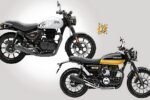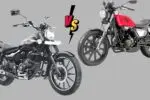The premium 150-200cc motorcycle segment in India is filled with exciting options for riders who demand both performance and style. Two of the strongest contenders in this space are the TVS Apache RTR 200 4V and the Yamaha MT-15 V2. Each bike has carved a distinct identity, appealing to different types of riders. Here, we present an in-depth, comprehensive comparison to help you choose the one that fits your needs best.
Contents
- 1 Design and Styling: Street-Fighter Appeal
- 2 Engine and Performance: Race Dynamics vs Torque Monster
- 3 Ride and Handling: Track-Bred vs Agile Street Slayer
- 4 Features and Technology: Tech-Savvy Machines
- 5 Comfort and Ergonomics: Sporty vs Relaxed
- 6 Braking and Safety: Confidence Boosters
- 7 Mileage and Efficiency: Economical Riders
- 8 Pricing and Value: Premium Choices
- 9 Final Verdict: Which One Should You Pick?
Design and Styling: Street-Fighter Appeal
The TVS Apache RTR 200 4V sports a muscular, aggressive look with sharp tank extensions, a chiselled body, and a striking LED headlamp setup. Its racing DNA is evident in the design language, backed by sporty decals and bold color schemes.
The Yamaha MT-15 V2 embodies the true spirit of a hyper naked streetfighter. Inspired by its larger siblings like the MT-09, the MT-15 V2 features a futuristic bi-functional LED headlamp, a sharp tail section, and an upright stance that gives it a distinctive road presence. Yamaha’s minimalistic yet aggressive design approach ensures that the MT-15 V2 turns heads effortlessly.
Verdict: If you love muscular, sporty bikes with racing character, the Apache RTR 200 4V will appeal more. If you prefer a sleek, futuristic streetfighter design, the MT-15 V2 is the clear winner.
Engine and Performance: Race Dynamics vs Torque Monster
The TVS Apache RTR 200 4V is equipped with a 197.75cc, oil-cooled, single-cylinder engine producing 20.82 bhp at 9,000 rpm and 17.25 Nm of torque at 7,250 rpm. The engine is mated to a 5-speed gearbox with a slipper clutch for smoother downshifts.
The Yamaha MT-15 V2, on the other hand, uses a 155cc, liquid-cooled, single-cylinder engine that churns out 18.4 bhp at 10,000 rpm and 14.1 Nm of torque at 7,500 rpm, paired with a 6-speed gearbox and an assist & slipper clutch. Yamaha’s famed VVA (Variable Valve Actuation) technology ensures a strong performance across the rev band.
Verdict: For raw power and stronger mid-range grunt, the Apache RTR 200 4V leads. For high-revving excitement, smoother highway cruising, and a more refined experience, the MT-15 V2 edges ahead.
Ride and Handling: Track-Bred vs Agile Street Slayer
The Apache RTR 200 4V is built for precision. With a race-tuned Showa suspension setup, adjustable front forks (in some variants), and dual-channel ABS, it delivers confidence-inspiring handling around corners and city traffic alike. The riding posture is slightly aggressive but comfortable for daily commuting and spirited riding.
The Yamaha MT-15 V2 comes with USD front forks and a Deltabox frame, enhancing its structural rigidity and handling prowess. The lightweight chassis and upright riding stance offer superb agility, especially in urban environments.
Verdict: If you are into corner carving and spirited weekend rides, the Apache RTR 200 4V suits better. For everyday nimbleness and effortless flickability, the MT-15 V2 is unbeatable.
Features and Technology: Tech-Savvy Machines
- TVS Apache RTR 200 4V offers:
- Fully digital instrument cluster with Bluetooth connectivity
- SmartXonnect technology for call/SMS alerts, navigation assist
- Ride modes (Urban, Rain, Sport)
- Adjustable front suspension
- Dual-channel ABS
- Yamaha MT-15 V2 offers:
- Negative LCD instrument cluster
- Bluetooth-enabled Y-Connect app integration
- USD forks
- Assist and slipper clutch
- Single-channel ABS
Verdict: The Apache RTR 200 4V is more feature-loaded and technologically advanced, offering value-packed innovations, while the MT-15 V2 keeps it minimalistic yet functional.
Comfort and Ergonomics: Sporty vs Relaxed
The TVS Apache RTR 200 4V has a sporty seating posture that leans slightly forward, engaging the rider for performance riding. The seat is comfortable enough for daily commutes but might feel a bit firm on longer rides.
The Yamaha MT-15 V2, with its upright handlebars and relaxed footpeg positioning, provides a more commuter-friendly and upright riding posture. It’s extremely comfortable for city rides and light touring.
Verdict: For aggressive riding comfort, the Apache RTR 200 4V excels. For day-long riding and urban use, the MT-15 V2 offers better ergonomics.
Braking and Safety: Confidence Boosters
Both motorcycles are equipped with disc brakes at both ends:
- Apache RTR 200 4V: Offers dual-channel ABS and super-moto ABS options (depending on variant).
- Yamaha MT-15 V2: Offers single-channel ABS.
Verdict: The Apache RTR 200 4V’s dual-channel ABS provides better braking confidence, especially on slippery surfaces.
Mileage and Efficiency: Economical Riders
The Apache RTR 200 4V delivers a real-world mileage of around 35-40 km/l, depending on the riding style.
The Yamaha MT-15 V2, known for its efficiency thanks to VVA, offers a real-world mileage of around 40-45 km/l.
Verdict: The MT-15 V2 offers better fuel efficiency, making it a better choice for longer daily commutes.
Pricing and Value: Premium Choices
- TVS Apache RTR 200 4V is priced around ₹1.52 lakh (ex-showroom) for the base variant.
- Yamaha MT-15 V2 is priced around ₹1.68 lakh (ex-showroom).
Verdict: The Apache RTR 200 4V offers better value for money considering the amount of features and performance it packs for a lower price.
Final Verdict: Which One Should You Pick?
- Choose the TVS Apache RTR 200 4V if you want a feature-loaded, powerful, track-inspired machine with better braking and value-for-money pricing.
- Choose the Yamaha MT-15 V2 if you desire a futuristic streetfighter design, superior fuel efficiency, nimble handling, and refined high-end performance.
Both motorcycles represent the best of their respective niches, and either choice will reward you with thrilling rides, reliability, and head-turning style.




